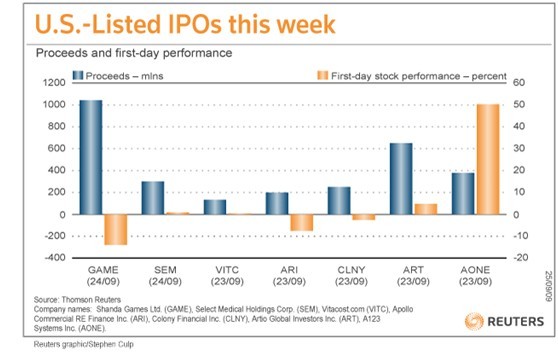

Domestic listing requirements call for minimum distribution of a company's shares within the United States as well as minimum financial criteria. Distribution of shares can be attained through U.S. public offerings, acquisitions made in the U.S., or by other similar means.
This chart is to be used for an initial evaluation only. For a more complete discussion of the minimum numerical standards applicable to U.S. companies, see Section 102.00 of the Listed Company Manual.
(a) The number of beneficial holders of stock held in "street name" will be considered in addition to the holders of record. The Exchange will make any necessary check of such holdings that are in the name of Exchange member organizations.
(b) In connection with initial public offerings, spin-offs and carve-outs the NYSE will accept an undertaking from the company's underwriter to ensure that the offering will meet or exceed the NYSE's standards.
|
Distribution & Size Criteria Must meet all 3 of the following: |
|
| Round-lot Holders (a) | 400 U.S. |
| Public Shares (b) | 1,100,000 outstanding |
| Market Value of Public Shares (b,c) | $40 million |
|
IPOs, Spin-offs, Carve-outs, Affiliates All Other Listings |
$100 million |
|
Stock Price Criteria All issuers must have a $4 stock price at the time of listing |
|
|
Financial Criteria Must meet 1 of the following standards: |
|
| Alternative #1 - Earnings Test (g) | |
| Aggregate pre-tax income for the last 3 years (d) | $12 million |
| Minimum in the most recent year | $5 million |
| Minimum in the next most recent year | $2 million |
| Alternative #2a - Valuation with Cash Flow (g) | |
| Global Market Capitalization (f) | $500 million |
| Revenues (most recent 12-month period) | $100 million |
| Adjusted Cash Flow: | |
| Aggregate for the last 3 years | $25 million |
| All 3 years must be positive | |
| Alternative #2b - Pure Valuation with Revenues | |
| Global Market Capitalization (f) | $750 million |
| Revenues (most recent fiscal year) | $75 million |
|
Alternative #3 - Affiliated Company For new entities with a parent or affiliated company listed on the NYSE |
|
| Global Market Capitalization (f) | $500 million |
| Operating History | 12 months |
| Parent or affiliate is a listed company in good standing | |
| Company's parent or affiliated company retains control of the entity or is under common control with the entity | |
| Alternative #4 - Assets and Equity | |
| Global Market Capitalization (f) | $150 million |
| Total Assets | $75 million |
| Stockholders' Equity | $50 million |
| REITs | |
| Stockholders' Equity (b) | $60 million |
| Funds and BDCs | |
| Net Assets (b) | $60 million |
| SPACs |
| The Exchange will consider on a case-by-case basis, the appropriateness for listing of acquisition companies with no prior operating history that conduct an initial public offering if the following criteria are met: |
| Proceeds held in trust upon IPO | 90% |
| Fair Market Value of Acquisitions | 80% of net assets |
| Aggregate Market Value | $250 million |
| Market Value of Public Shares | $200 million |
(c) If a company either has a significant concentration of stock or changing market forces have adversely impacted the public market value of a company that otherwise would qualify for an Exchange listing, such that its public market value is no more than 10 percent below the minimum, the Exchange will consider stockholders' equity of $60 million or $100 million, as applicable, as an alternate measure of size.
(d) Pre-tax income is adjusted for various items as defined in Section 102.01C of the NYSE Listed Company Manual.
(e) Represents net cash provided by operating activities excluding the changes in working capital or in operating assets and liabilities, as adjusted for various items as defined in Section 102.01C of the NYSE Listed Company Manual.
(f) Global market capitalization for already existing public companies is represented by the most recent three months of trading history in the case of Pure Valuation with Revenues. For all other standards, the measurement is "point in time" for existing public companies. For IPOs, spin-offs and carve-outs, it is represented by the valuation of the company as represented by, in the case of a spin-off, the distribution ratio as priced, or, in the case of an IPO/carve-out, the as-priced offering in relation to the total company's capitalization.
(g) For Emerging Growth Companies presenting two fiscal years and qualifying under Alternative #1, pre-tax income must total at least $10 million in the aggregate in the last two fiscal years together with a minimum of $2 million in both years. For Emerging Growth Companies presenting two fiscal years and qualifying under Alternative #2a, aggregate cash flow must total $25 million for the last two fiscal years, with positive amounts in both years.
Additional Considerations
In addition to meeting the minimum numerical standards listed above, there are other factors which must necessarily be considered. The company must be a going concern or be the successor to a going concern.
The Exchange has broad discretion regarding the listing of a company. The Exchange is committed to list only those companies that are suited for auction market trading and that have attained the status of being eligible for trading on the Exchange. Thus, the Exchange may deny listing or apply additional or more stringent criteria based on any event, condition, or circumstance that makes the listing of the company inadvisable or unwarranted in the opinion of the Exchange. Such determination can be made even if the company meets the standards set forth above.



















